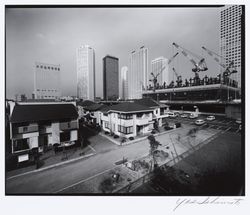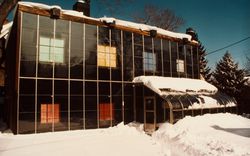archives
Level of archival description:
Fonds
John Hejduk fonds
AP145
Synopsis:
The John Hejduk fonds documents the professional practice of architect John Hejduk. Drawings of nearly every project by Hejduk are present, with many of his most significant architectural, exhibition, and publishing projects particularly well represented. Material in this fonds was produced between 1947 and 2000.
1947-2000, predominant 1947-1996
John Hejduk fonds
Actions:
AP145
Synopsis:
The John Hejduk fonds documents the professional practice of architect John Hejduk. Drawings of nearly every project by Hejduk are present, with many of his most significant architectural, exhibition, and publishing projects particularly well represented. Material in this fonds was produced between 1947 and 2000.
archives
Level of archival description:
Fonds
1947-2000, predominant 1947-1996
archives
Level of archival description:
Fonds
CP138
Synopsis:
The Gordon Matta-Clark collection documents the personal and professional activities of Gordon Matta-Clark through his correspondence, texts, library, artwork and films, created predominantly between 1969 and 1978. Additionally the collection contains correspondence and photographs collected by Anne Alpert, Matta-Clark's mother, and documentation on his work collected by his widow Jane Crawford following his death.
1914-2008
Gordon Matta-Clark collection
Actions:
CP138
Synopsis:
The Gordon Matta-Clark collection documents the personal and professional activities of Gordon Matta-Clark through his correspondence, texts, library, artwork and films, created predominantly between 1969 and 1978. Additionally the collection contains correspondence and photographs collected by Anne Alpert, Matta-Clark's mother, and documentation on his work collected by his widow Jane Crawford following his death.
archives
Level of archival description:
Collection
1914-2008
Sub-series
AP156.S4.SS5.D10
Description:
Le dossier documente les photographies prises par un ou des photographes non identifiés de Chandigarh, en Inde. Le dossier inclut des photographies de la vie quotidienne à Chandigarh, des paysages de Chandigarh, des résidences privées et gouvernementales, des écoles, de l'Université du Panjab, du Capitol, de divers bâtiments et installations, de maquettes, de mobilier créé par Pierre Jeanneret et des signes de Le Corbusier. Le matériel dans ce dossier a été produit entre 1950 et ls années 1970. Le dossier contient des photographies. File documents the photographs taken by unidentified photographers. The file includes photographs of the everyday life at Chandigarh, Chandigarh's landscapes, private and governmental residences, schools, the Panjab University, the Capitol, miscellaneous buildings and installations, models, furniture designed by Pierre Jeanneret and Le Corbusier's signs. The material in this file was produced between 1950 and in the 1970s. The file contains photographs.
1950-1970s
Photographes inconnus = Unknown photographers
Actions:
AP156.S4.SS5.D10
Description:
Le dossier documente les photographies prises par un ou des photographes non identifiés de Chandigarh, en Inde. Le dossier inclut des photographies de la vie quotidienne à Chandigarh, des paysages de Chandigarh, des résidences privées et gouvernementales, des écoles, de l'Université du Panjab, du Capitol, de divers bâtiments et installations, de maquettes, de mobilier créé par Pierre Jeanneret et des signes de Le Corbusier. Le matériel dans ce dossier a été produit entre 1950 et ls années 1970. Le dossier contient des photographies. File documents the photographs taken by unidentified photographers. The file includes photographs of the everyday life at Chandigarh, Chandigarh's landscapes, private and governmental residences, schools, the Panjab University, the Capitol, miscellaneous buildings and installations, models, furniture designed by Pierre Jeanneret and Le Corbusier's signs. The material in this file was produced between 1950 and in the 1970s. The file contains photographs.
Dossier 10
1950-1970s
Tokyo: Yasuhiro Ishimoto
After spending most of his life in the United States, photographer Yasuhiro Ishimoto (1921–2012) settled in Tokyo in 1961 and began a study of the city distinct from the street photography of his contemporaries. For the next fifty years, the shifting spaces and people of Tokyo made up the core of Ishimoto’s work. Tokyo: Yasuhiro Ishimoto features a selection of(...)
Hall cases
28 June 2012 to 21 October 2012
Tokyo: Yasuhiro Ishimoto
Actions:
Description:
After spending most of his life in the United States, photographer Yasuhiro Ishimoto (1921–2012) settled in Tokyo in 1961 and began a study of the city distinct from the street photography of his contemporaries. For the next fifty years, the shifting spaces and people of Tokyo made up the core of Ishimoto’s work. Tokyo: Yasuhiro Ishimoto features a selection of(...)
Hall cases
The greystone buildings standing in Montreal today are essential tools for understanding the city. A deep study of their material history from the late 17th century to the early 20th demonstrates how geology, topography, politics, ethnicity, culture, as well as changes in economy and technology, have shaped the city through the centuries. Conceived as a photographic(...)
Octagonal gallery Keyword(s):
Greystone, Phyllis Lambert, Montréal, photography, Richard Pare
13 October 2017 to 4 March 2018
Greystone: Tools for Understanding the City
Actions:
Description:
The greystone buildings standing in Montreal today are essential tools for understanding the city. A deep study of their material history from the late 17th century to the early 20th demonstrates how geology, topography, politics, ethnicity, culture, as well as changes in economy and technology, have shaped the city through the centuries. Conceived as a photographic(...)
Octagonal gallery Keyword(s):
Greystone, Phyllis Lambert, Montréal, photography, Richard Pare
articles
The planet is the client
articles
The planet is the client
3 August 2023, 6pm to 7:30pm
Sub-series
AP207.S2.SS09
Description:
The sub-series documents the exhibition "Radicals. Architettura e design 1960-1975", curated by Pettena and presented in the Italian Pavilion at the Venice Biennale in 1996. This documentary exhibition on the Radical architecture movement in the 1960s and the 1970s, for presented the Radical movement not as "essentially conceptual contribution, as “fantastic” theories and utopian visions of the future" [1] but as "precursors of the most innovative production of the contemporary, international architectural scene." [2] The sub-series contains research material, including photocopies of articles on the Radical movement and research on previous editions of the Venice Biennale. It also contains correspondence for the planning of the exhibition, including with Hans Hollein and the Biennale administration, a draft exhibition proposal, concept development notes by Pettena, proposals for promotional material on the exhibition and press clippings. Source: [1][2] Gianni Pettena website, https://www.giannipettena.it/english/exhibitions/settings/ (last accessed 29 January 2020).
1992-2010
Radicals. Architettura e Design 1960-1975 (1992)
Actions:
AP207.S2.SS09
Description:
The sub-series documents the exhibition "Radicals. Architettura e design 1960-1975", curated by Pettena and presented in the Italian Pavilion at the Venice Biennale in 1996. This documentary exhibition on the Radical architecture movement in the 1960s and the 1970s, for presented the Radical movement not as "essentially conceptual contribution, as “fantastic” theories and utopian visions of the future" [1] but as "precursors of the most innovative production of the contemporary, international architectural scene." [2] The sub-series contains research material, including photocopies of articles on the Radical movement and research on previous editions of the Venice Biennale. It also contains correspondence for the planning of the exhibition, including with Hans Hollein and the Biennale administration, a draft exhibition proposal, concept development notes by Pettena, proposals for promotional material on the exhibition and press clippings. Source: [1][2] Gianni Pettena website, https://www.giannipettena.it/english/exhibitions/settings/ (last accessed 29 January 2020).
Subseries
1992-2010
Series
Photographies = Photographs
AP156.S4
Description:
La série documente la vie personnelle et professionnelle de Pierre Jeanneret, en Europe et en Inde, ainsi que le projet de la nouvelle ville de Chandigarh, en Inde. La série inclut principalement des photographies de Chandigarh, mais aussi des photographies de familles, des photographies de quelques projets qu'il a réalisé en Europe dans les années 1940. Le matériel de cette série a été produit entre la fin des années 1800 jusqu'au années 1970. La série contient principalement des photographies, donc des épreuves contacts ou des photocollages, ainsi que des négatifs. Series documents the personnal and professional life of Pierre Jeanneret, in Europe and in India, and also the project for the new city of Chandigarh, in India. The series includes predominantly photographs of Chandigarh, but also family photographs and photographs of a few of his projects in Europe in the 1940s. The material in this series was produced between the end of the 1800s to the 1970s. The series contains predominantly photographs, including contact sheets and photocollages, and also negatives.
Photographies = Photographs
Actions:
AP156.S4
Description:
La série documente la vie personnelle et professionnelle de Pierre Jeanneret, en Europe et en Inde, ainsi que le projet de la nouvelle ville de Chandigarh, en Inde. La série inclut principalement des photographies de Chandigarh, mais aussi des photographies de familles, des photographies de quelques projets qu'il a réalisé en Europe dans les années 1940. Le matériel de cette série a été produit entre la fin des années 1800 jusqu'au années 1970. La série contient principalement des photographies, donc des épreuves contacts ou des photocollages, ainsi que des négatifs. Series documents the personnal and professional life of Pierre Jeanneret, in Europe and in India, and also the project for the new city of Chandigarh, in India. The series includes predominantly photographs of Chandigarh, but also family photographs and photographs of a few of his projects in Europe in the 1940s. The material in this series was produced between the end of the 1800s to the 1970s. The series contains predominantly photographs, including contact sheets and photocollages, and also negatives.
Série 4




